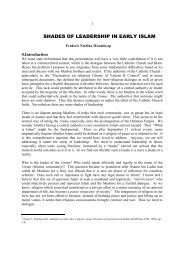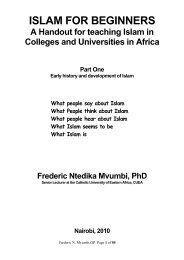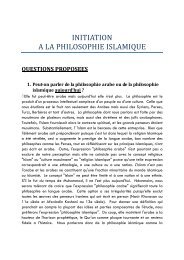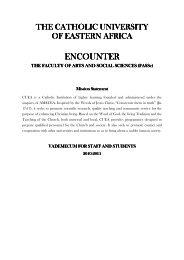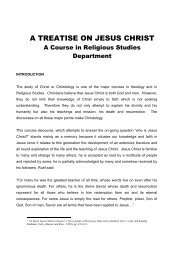INTRODUCTION TO ISLAMIC THEOLOGY.pdf - CUEA
INTRODUCTION TO ISLAMIC THEOLOGY.pdf - CUEA
INTRODUCTION TO ISLAMIC THEOLOGY.pdf - CUEA
You also want an ePaper? Increase the reach of your titles
YUMPU automatically turns print PDFs into web optimized ePapers that Google loves.
24have been primarily directed against proto-Shî`ites, since a preponderant number of the Murji’iteslisted by Ibn-Sa'd (d. 845) and Ibn-Qutayba (d. 889) are from Kûfa. By opposing the divisivetendencies of the Khârijites and Shî`ites and upholding the unity of the Islamic community, theMurji’ites are forerunners of the Sunnites.Irjâ’ 2: Faith does not include worksThe second application of irjâ’’ was with regard to faith and practice; practice was postponed, orplaced after, faith. This application of irjâ’ was demanded by the first. If judgement is to be deferredwhether a grave sinner is a believer or not, he is really accepted as a believer, although lacking inthe practice of faith. That is because the Arabs’’ communal way of thinking made them look upon abeliever primarily as a “member of a believing community” rather than simply “one who has faith”. Ifa grave sinner is accepted as a member of the Muslim community, then he must have faith, andfaith (îmân) must be defined accordingly.In the Qur’ân and the Hadîth a distinction is sometimes drawn between îmân and islâm (andsometimes ihsân, doing good). Îmân is the profession of faith from the heart and mouth, whileislâm is serving God, especially through salât and zakât. Islamic theological literature gives variousways of distinguishing the two, mainly by saying that îmân is of a higher or lesser value than islâm.Murji’ite theologians, as will be seen, gave îmân a meaning equivalent to “accepting the officialreligion”.Abû-Hanîfa, if we accept W. Montgomery Watt’s historical investigation, was the chief theologian ofMurji’ism and was not a heretic, but initiated the ideas that were to prevail in later Sunnism. Theproblem he faced was to find an intermediate position between rigorism and laxism. The Khârijiteand Mu'tazilite rigorist position caused moral anxiety, because by sin a person would be deprivedof îîmân and membership in the community.Anxiety was furthered by the Hanbalite practice of applying the phrase ““in shâ’’ Allâh” (If God wills)even to one’s own belief by saying, “I am a believer, if God wills”. They said this because theyconsidered obedience to the laws of the Qur’ân part of faith, and they were not so self-confident toassert that they had fulfilled all the requirements of the law.To correct the rigorist trend some people turned to a laxist position; for example Muqâtil ibn-Sulaymân (d. 767) said, “Where there is îmân, sin does no harm”. This statement of Muqâtil(member of the Zaydite sect) is what later Sunnite writers wrongly considered central in Murji’ism,and is the reason why they considered Murji’ism a heresy.Abû-Hanîfa’s solution was to define îmân as “confession (iqrâr) with the tongue and counting true(tasdîq) with the heart”. ÎÎmân is thus an intellectual acceptance of the basic tenets of Islam, anddoes not include fulfilling the Law. It is moreover the distinguishing factor between belonging to theMuslim community or not; someone either has îmân or he does not. Therefore, Abû-Hanîfaconcluded, it is equal among all Muslims and does not increase or decrease in degree. Faith staysthe same, and only practice can increase or decrease.The Hanbalites, including al-Ash'arî, opposed this definition of îmân, and asserted that faithincludes practice and does increase or decrease. They cited in favour of their view Qur’ân versessuch as 8:2: “Believers are only those whose hearts shake when God is mentioned; and when hissigns are recited to them, it increases their faith.” The Hanafite view, however, prevailed in laterSunnite orthodoxy.




